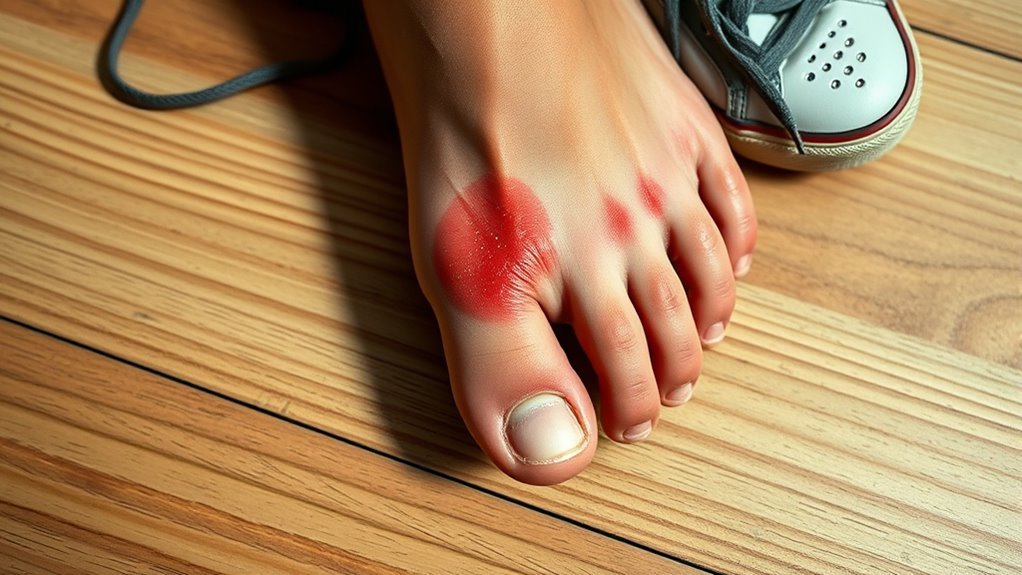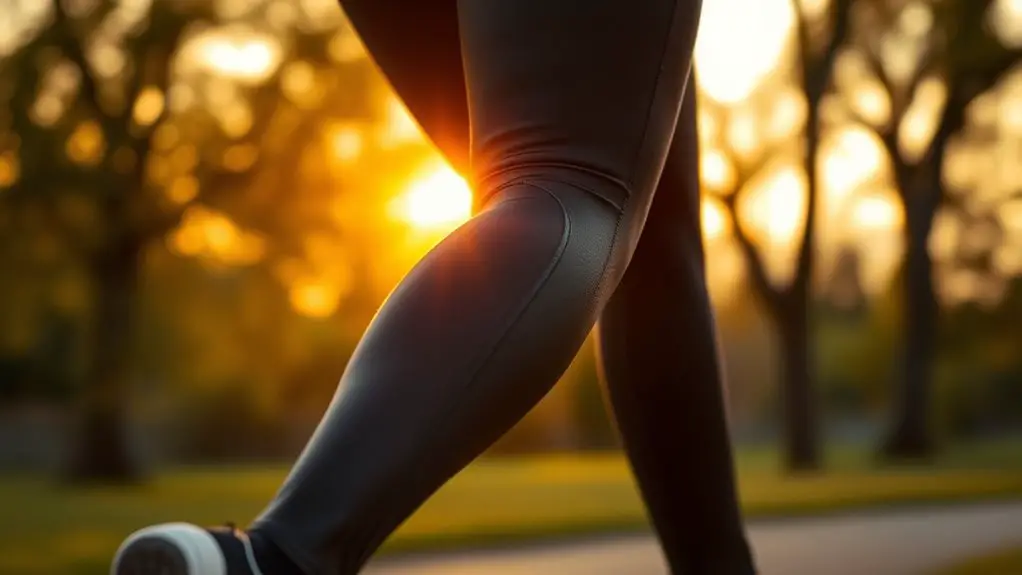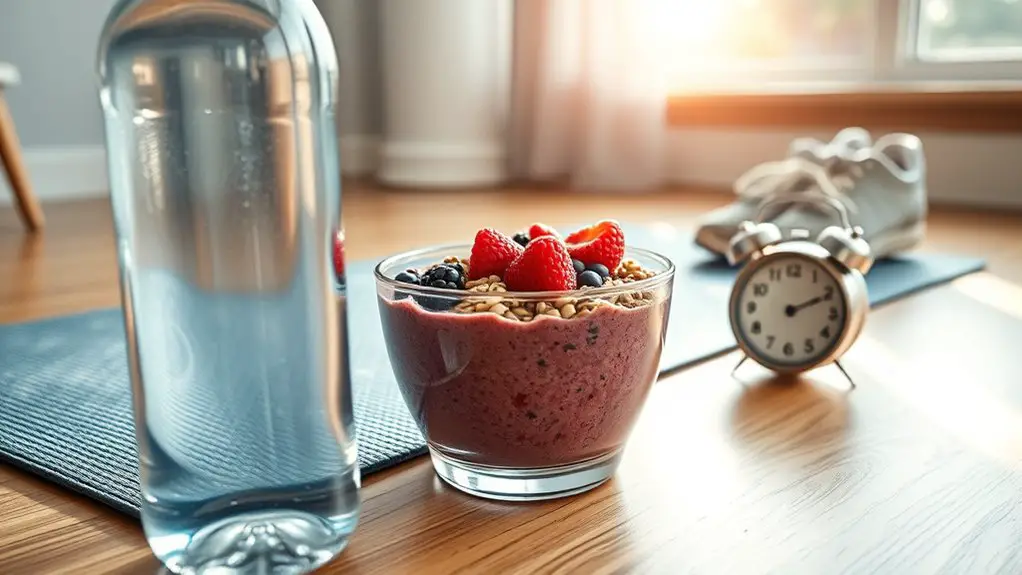Yes, athlete’s foot is definitely itchy. The infection causes intense itching, especially between the toes and on the soles of your feet. This itchiness happens due to the fungal invasion irritating your skin and stimulating nerve endings. While scratching might give you temporary relief, it can actually worsen the irritation. If you’re looking for ways to manage the itch and other symptoms, keep going to explore more helpful information.
Understanding Athlete’s Foot
What exactly is athlete’s foot? It’s a fungal infection that thrives in warm, damp environments, often targeting your feet. Understanding its causes is key to living freely without the discomfort it brings. The fungi can spread through direct contact or contaminated surfaces, like locker rooms or shared showers. To keep this pesky issue at bay, you’ll want to adopt some solid prevention strategies. Always wear moisture-wicking socks and breathable footwear, and keep your feet dry, especially between your toes. Regularly change your socks and avoid walking barefoot in public areas. By staying informed and proactive, you can embrace life without the nagging worry of athlete’s foot holding you back. Freedom starts with good foot health!
Common Symptoms of Athlete’s Foot
When you have athlete’s foot, an intense itching sensation is often one of the first signs you’ll notice. Along with the itching, you might experience redness, peeling, or even blisters. Understanding the severity of these symptoms can help you decide when to seek treatment.
Itching Sensation Description
Although you might not realize it at first, the itching sensation associated with athlete’s foot can be quite intense and uncomfortable. It often starts subtly but can escalate quickly, leaving you desperate for relief. You may notice that the itch sensation is accompanied by skin irritation, making the affected area feel raw and sensitive. It can feel like a persistent tickle or a burning sensation that just won’t quit. Scratching can provide temporary relief, but it can also worsen the irritation and lead to further complications. The key is to recognize this discomfort early, as managing the itch sensation effectively can help you regain your freedom from the nagging effects of athlete’s foot and restore your sense of well-being.
Other Common Symptoms
Along with the itching, athlete’s foot can present a range of other common symptoms that can make the condition even more bothersome. You might experience redness and swelling between your toes or on the soles of your feet, which can lead to significant skin irritation. Peeling or cracking skin is also common, often making walking uncomfortable. In some cases, blisters can form, adding to the overall discomfort. If the fungal infection spreads, you may notice a foul odor, which can be embarrassing. It’s crucial to address these symptoms promptly to regain your comfort and freedom. Remember, managing the fungal infection effectively can help alleviate itching and the other annoying symptoms that come with athlete’s foot.
Severity of Symptoms
How severe can the symptoms of athlete’s foot really get? The itch severity can vary widely from person to person. Some folks experience mild itching and redness, while others may face intense discomfort, making it hard to focus on anything else. In symptom comparison, you might notice that some experience blistering or peeling skin, which can worsen if left untreated. The severity often depends on how quickly you address the infection. If you ignore the signs, you could end up with a more serious condition, leading to painful cracks and even secondary infections. So, if you’re feeling that itch, don’t wait—take action and reclaim your freedom from discomfort!
The Itch Factor: Why Does It Happen?
Why does athlete’s foot come with such an intense itch? The answer lies in your body’s skin response to infection. When fungus invades your skin, it releases irritants that trigger your nerve endings, creating that maddening itch. It’s your body’s way of signaling that something’s off, urging you to address the problem. Itch triggers can vary, but moisture and warmth amplify the sensation. As you scratch, you might think you’re relieving the itch, but you’re actually exacerbating the issue, causing more irritation. This cycle can be frustrating, but understanding the mechanics behind it helps you take control. Embrace the freedom to manage your symptoms effectively, so you can reclaim comfort and enjoy life without being held back by that relentless itch.
Causes of Athlete’s Foot Itchiness
While you might think athlete’s foot itchiness is just a nuisance, it actually stems from several underlying causes. The primary culprit is fungal infections, specifically the dermatophyte fungi that thrive in warm, moist environments. When these fungi invade your skin, they trigger an inflammatory response, leading to that maddening itch. Additionally, skin irritation can occur from excessive sweating, tight footwear, or not allowing your feet to breathe. If your skin’s barrier is compromised, it becomes more susceptible to irritants and allergens, heightening the itchiness. Remember, the freedom to enjoy your activities can be hampered by these pesky symptoms, so understanding their causes can empower you to take action and reclaim your comfort.
Treatment Options for Athlete’s Foot
Dealing with the itchiness of athlete’s foot can be frustrating, but effective treatment options are available to help you find relief. You can take control with various approaches, including topical treatments and antifungal medications. Here’s a quick overview of your options:
| Treatment Type | Examples | Application Method |
|---|---|---|
| Topical Treatments | Clotrimazole, Miconazole | Apply directly to the affected area |
| Antifungal Medications | Terbinafine, Ketoconazole | Follow prescription guidelines |
| Over-the-Counter | Lotrimin, Tinactin | Use as directed on packaging |
| Natural Remedies | Tea tree oil | Dilute and apply cautiously |
| Prevention Tips | Keep feet dry | Change socks regularly |
With the right treatment, you can reclaim your comfort and enjoy life without the annoying itch!
Home Remedies to Alleviate Itching
If you’re looking for ways to ease the itch of athlete’s foot at home, several remedies can provide relief. You don’t have to rely solely on over-the-counter options; natural remedies can be just as effective. Consider trying these soothing ointments and treatments:
- Tea tree oil: Its antifungal properties can help reduce itching and inflammation.
- Aloe vera gel: Known for its soothing qualities, it can provide instant relief from irritation.
- Baking soda paste: Mix with water to create a paste that can help dry out the affected area and alleviate itching.
These remedies can empower you to take control of your comfort without relying solely on commercial products. Enjoy your freedom from that annoying itch!
Preventing Athlete’s Foot and Its Symptoms
To keep athlete’s foot at bay and minimize its symptoms, proactive measures are key. First, focus on your footwear choices—opt for breathable shoes that allow air circulation and keep your feet dry. Avoid tight-fitting shoes, as they can trap moisture. When possible, go barefoot at home or wear sandals to let your feet breathe. Additionally, always wear flip-flops in public showers or pools to reduce exposure to fungi. It’s also important to keep your feet clean and dry, especially between the toes. Regularly changing socks and using antifungal powders can further protect against infection. By adopting these preventative measures, you can enjoy your activities without the nagging worry of athlete’s foot creeping in. Freedom starts with healthy feet!
Frequently Asked Questions
Can Athlete’s Foot Spread to Other Parts of the Body?
Yes, athlete’s foot can spread to other parts of your body, especially if you don’t treat it properly. To prevent this, keep your feet clean and dry, and avoid walking barefoot in public places. If you notice symptoms, consider over-the-counter antifungal treatments. Regularly washing your towels and shoes can also help. Remember, taking these prevention tips seriously will help you maintain that freedom to enjoy life without the hassle of athlete’s foot.
Is Athlete’s Foot Contagious Between People?
Yes, athlete’s foot is contagious between people. You can easily catch it through direct contact with an infected person or by touching contaminated surfaces, like locker room floors or shared footwear. This fungal infection spreads rapidly, especially in warm, moist environments. To protect yourself, maintain good foot hygiene, wear breathable footwear, and avoid walking barefoot in public areas. Staying vigilant can help you enjoy your freedom without the worry of this pesky infection!
How Long Does Athlete’s Foot Itching Last?
The itch duration of athlete’s foot can vary, usually lasting a few days to a couple of weeks if untreated. To manage symptoms, keep your feet clean and dry, and consider over-the-counter antifungal creams. You might also want to wear breathable footwear to reduce moisture. If the itching persists beyond two weeks, it’s best to consult a healthcare professional for more effective treatments. Don’t let the itch limit your freedom!
Can Athlete’s Foot Be Mistaken for Other Skin Conditions?
Yes, athlete’s foot can definitely be mistaken for other skin conditions. You might find its symptoms resemble eczema, with redness and scaling. Plus, the similarities to psoriasis, like flaky patches, can lead to confusion. It’s important to remember that accurate diagnosis is key to effective treatment. If you’re uncertain, consult a healthcare professional to guarantee you get the freedom from discomfort you deserve, rather than relying on guesswork.
Are There Specific Footwear That Can Worsen Athlete’s Foot?
Yes, certain footwear can worsen athlete’s foot. Shoes made from non-breathable materials, like plastic or synthetic fabrics, can trap moisture, creating an ideal environment for fungi. If you’re looking for freedom for your feet, opt for breathable materials like canvas or leather. These allow air circulation and reduce moisture retention. Avoid tight-fitting shoes that can irritate your skin and promote fungal growth. Choosing the right footwear is key to staying comfortable and healthy.




